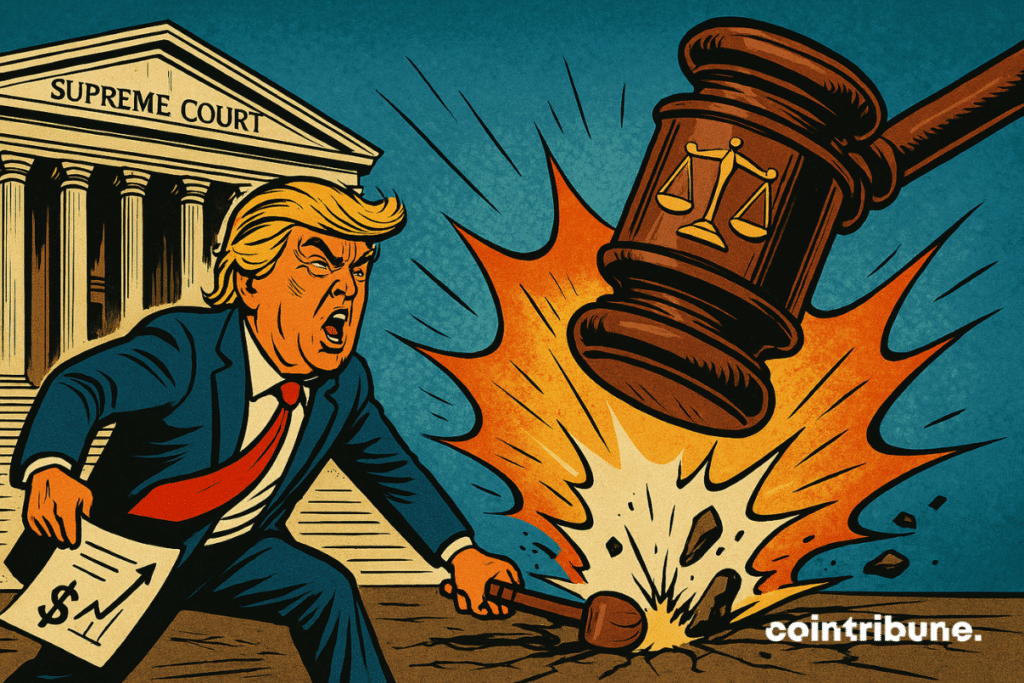Supreme Court Questions Trump’s Emergency Trade Authority
Kalshi and Polymarket record a sharp drop in probabilities in favor of Donald Trump, as the Supreme Court examines the legality of his tariff powers. This turnaround highlights two dynamics : the possible rollback of presidential authority over foreign trade, and the growing role of decentralized platforms as sensors of political anticipation. A case where constitutional law, economic strategy, and technology intersect under the watchful eyes of judges… and investors.

In brief
- Kalshi and Polymarket record a spectacular drop in probabilities in favor of Donald Trump.
- Markets anticipate an unfavorable Supreme Court decision on his tariff powers.
- More than $1.3 million has been wagered by traders on the outcome of this highly political case.
- Several magistrates have questioned the legitimacy and scope of presidential tariff powers.
Prediction markets disavow Trump’s position
The silent battle over American presidential powers is now being played out on prediction platforms, while the American justice system had declared the tariffs illegal.
While the Supreme Court examines the constitutional grounds of the tariffs imposed by Donald Trump via the 1977 IEEPA, the markets anticipate an unfavorable verdict for the president.
This Thursday, the regulated American platform Kalshi showed only 29 % probability that the Supreme Court would rule in favor of the president, a drop of 28 points in a single day.
On Polymarket, a decentralized platform based on blockchain and whose contracts are settled in USDC, the confidence level is even lower, at 25 %. The total cumulative volume traded on both platforms has exceeded $1.3 million, reflecting tangible interest and nervousness around this case. This dynamic reflects a shared reading between traditional investors and crypto users, who adjust their positions in response to what they perceive as a turnaround.
These market movements are closely linked to traders’ reassessment of the judicial context. Since the Supreme Court agreed to take up the case in September, positions have tightened around a central point: the president’s ability to invoke the 1977 emergency law (International Emergency Economic Powers Act) to impose tariffs without Congressional approval. The sharp reversal, described by Kalshi as the largest daily drop observed on the contract, reflects several factual elements :
- The realization that the trial’s outcome is now perceived as unfavorable to Trump by a majority of actors ;
- A rapid repositioning on both platforms, with probabilities aligned around 25-29 % ;
- An increase in traded volume as investors seek to reposition or exit their contracts ;
- A notable convergence between traditional markets (Kalshi) and decentralized markets (Polymarket), reading judicial signals and other on-chain data with the same probabilistic analysis framework.
Judges question : The Supreme Court faces the limits of executive power
During the oral hearing held this Wednesday by the United States Supreme Court, several conservative judges expressed marked skepticism about the position defended by the Trump administration.
Indeed, Judge Neil Gorsuch warned of the risk of creating a “one-way ratchet”, which would permanently tilt the institutional balance in favor of the executive branch. Amy Coney Barrett, also appointed by Trump, questioned government representatives on the logic of targeting countries like France or Spain within a framework supposed to address an emergency situation. Finally, the Chief Justice of the Court, John Roberts, reminded that “tariffs, as a form of tax, have historically been under Congress’ jurisdiction”.
These statements reveal a potential challenge to the use of the International Emergency Economic Powers Act (IEEPA) to justify unilateral trade policies. The judges appear concerned about an executive power drift, which if confirmed in this case, could assume budgetary prerogatives without parliamentary checks.
If the Court were to restrict the current interpretation of the IEEPA, the consequences would be multiple. From a legal perspective, it would set a precedent limiting the American president’s room for maneuver on international trade issues.
From an economic standpoint, it could reduce uncertainty related to ad hoc tariff policies, often a source of market volatility. And for cryptos, traditionally sensitive to geopolitical tensions, this could ultimately translate into fewer abrupt movements linked to unilateral announcements, and thus a reduced perception of bitcoin as a safe haven, with a correlation to gold reaching 0.85, against this type of risk.
Maximize your Cointribune experience with our "Read to Earn" program! For every article you read, earn points and access exclusive rewards. Sign up now and start earning benefits.
Diplômé de Sciences Po Toulouse et titulaire d'une certification consultant blockchain délivrée par Alyra, j'ai rejoint l'aventure Cointribune en 2019. Convaincu du potentiel de la blockchain pour transformer de nombreux secteurs de l'économie, j'ai pris l'engagement de sensibiliser et d'informer le grand public sur cet écosystème en constante évolution. Mon objectif est de permettre à chacun de mieux comprendre la blockchain et de saisir les opportunités qu'elle offre. Je m'efforce chaque jour de fournir une analyse objective de l'actualité, de décrypter les tendances du marché, de relayer les dernières innovations technologiques et de mettre en perspective les enjeux économiques et sociétaux de cette révolution en marche.
The views, thoughts, and opinions expressed in this article belong solely to the author, and should not be taken as investment advice. Do your own research before taking any investment decisions.